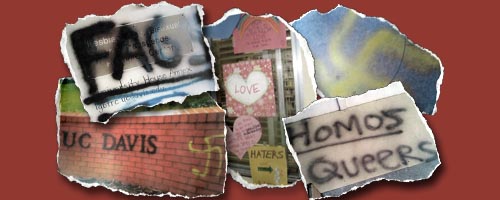|
|
What happens when a swastika is found etched into a campus dormitory door? What is the appropriate action to take when a center, dedicated to promoting lesbian, gay, transgender, and bisexual students, is defaced with hateful graffiti? How does the university respond? How can the campus restore safety, dignity, and civility?
UC Davis had to contend with these questions in 2010.
On February 19, 2010 a swastika was found carved into the door of a Jewish student in the Tercero dorm. On February 26, the LGBT Resource Center (LGBTRC) was found defaced with homophobic slurs sprayed in graffiti on the door. On March 3, three more swastikas were discovered spray painted around campus and 11 days later a fifth swastika was found in a dorm room hallway. On September 29, 2010 the Third World Mural at the Memorial Union was defaced. On October 3, two men pushed and grabbed two people on campus while yelling racist and anti-gay slurs.
The campus community responded quickly to these incidents.
The LGBTRC elected not to immediately paint over the hateful graffiti, but instead to allow the campus to view the homophobic words. LGBTRC director Sheri Atkinson explained that “as a center we wanted not to immediately remove the vandalism in order to ensure that this hate crime does not go unnoticed by the campus community.” The LGBTRC wanted to show the campus community that hateful incidents are neither a thing of the past nor events that only appear in newspapers. Members of the campus community tagged the center with love notes supporting the LGBT community and expressing outrage at the hateful graffiti.
The administration launched a comprehensive response to the incident through the “Hate Free Campus Initiative.” To implement the Hate Free Campus Initiative, the Campus Council on Community and Diversity (CCC&D) created two subcommittees. The first, “Academic Issues and Concerns” is tasked with reviewing course selection and general education requirements to ensure that each student receives courses on diversity. The second, “Student Life Issues and Campus Climate” is tasked with increasing the number of underrepresented students on campus. Additionally, the Hate Free Campus Initiative endeavors to reach the entire campus community through a series of events including a distinguished speaker series, a Principles of Community Celebration Week, and Cultural Days.
Responding to incidents of hate is neither easy nor universally respected. While it may sound beneficial to impose a diversity requirement on incoming students, some argue that a mandatory diversity course limits student choice and even imposes a certain viewpoint dictated by the university or forces students to conform to what some see is a politically correct agenda. Donald Downs argues in his book Restoring Free Speech and Liberty on Campus that, “institutions of higher education have continued to repress speech and ideas deemed contrary to the ideology of sensitivity” (xx).
The type of hateful incident often determines the response. Unlike the incidents at UCSD, which all targeted African American students and allowed for a more specific response, the hate crimes at Davis proved more complicated to address. Chancellor Katehi allocated $100,000 to the LGBT Resource Center to increase resources and support for the campus LGBT community. The other incidents forced more general responses to attempt to improve the campus climate, raise awareness of hate crimes, and combat discrimination and prejudice.
The expressions of intolerance at UC Davis force us to consider what is the appropriate response to these moments of hate. While these incidents of extreme incivility produce real and intense pain, they also push the campus to undertake initiatives that may ultimately lead to greater tolerance, inclusivity, and civility. Each incident of hate creates at least an opportunity to renegotiate the kind of community each university strives toward and to build a stronger, more intellectual, and more welcoming environment.

|



